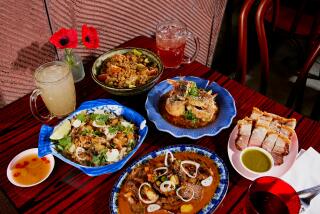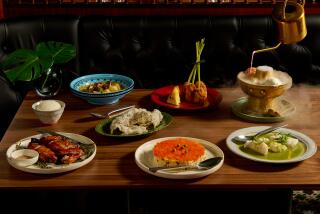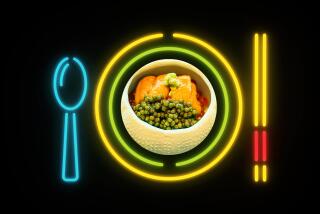Simplicity along the Mekong
Southeast Asia has become so well-traveled in recent years that it’s difficult to find an interesting spot that also offers Westerners an unadorned look at local life.
Hmong villages in Vietnam and northern Thailand are tourist showcases. Resorts in Bali, Indonesia, and Phuket, Thailand, offer sanitized markets for tourists who may be squeamish about the real thing. And now it’s possible to play tennis not far from the temples of Angkor Wat, Cambodia. That was only a developer’s dream when I visited that archeological gem in 1996.
This would explain my delight in Louangphrabang, which I visited in November with my husband, Ken Stern, and our 6-year-old son, Jack. This small, charming city in northern Laos is known for its old architecture and easygoing culture. The former royal capital, a UNESCO World Heritage Site, is the location of Wat Xieng Thong, the country’s most treasured temple.
Once I got here I discovered even better attractions: being able to sample life along the Mekong River and visit nearby villages while enjoying the city’s outstanding cuisine and Western amenities at affordable prices.
Louangphrabang is only 90 minutes by air from Bangkok but a world apart from that bustling Thai city. Louangphrabang, tucked at the confluence of the Mekong and Nam Khan rivers and surrounded by green mountains, more closely resembles a small town, although it has a population of about 70,000.
Traffic lights are unnecessary because there are few cars. Only four years ago, Laos’ chief transportation was the bicycle. Most women wear the traditional sihn, a calf-length tube skirt made of woven fabric. The main shopping area, which runs half a mile along Xieng Thong Road, consists largely of 19th century shops with brightly colored wooden shutters, a remnant of the French colonialists.
Recorded Laotian history dates to 1353, to the reign of the warrior king Fa Ngoun, who established the boundaries of present-day Laos and introduced Buddhism to Laotians. France annexed the territory in the late 19th century, and it languished as a sleepy part of French Indochina until World War II. In March 1945 the Japanese occupied Laos, and in April, the country declared its independence. But the French reestablished control in 1946. Few Americans took notice of landlocked Laos until the Vietnam War, when the U.S. launched a bombing campaign to halt infiltration of the country by communist North Vietnamese. In 1975, a communist government took control and changed its name to the Lao People’s Democratic Republic.
Although we saw no signs of anti-American sentiment in Louangphrabang, last month the U.S. State Department issued a warning of sporadic attacks against American tourists in Laos.
Through all this tumult, Buddhism has remained a constant, and signs of it are visible everywhere in Louangphrabang. You can’t walk for more than five minutes without seeing one of the city’s more than 30 temples, or wats. They date from the 16th to the 19th centuries and are made of gilded wood or stucco and brick. Even new construction projects in the old part of the city are built of brick and stucco, to resemble mansions the French built, or Laotian-style in wood on stilts.
We began most days at dawn by giving alms (packets of rice wrapped in a banana leaf) to the procession of Buddhist monks on Xieng Thong Road. A drum signaled the start of this morning ritual, in which several hundred monks, their heads shaved, walked barefoot in the mist, carrying black lacquered bowls and wearing only turmeric-colored cotton robes. Natives, as well as tourists, offered them sustenance: The monks rely on these donations for their daily meals. In the Buddhist religion, such good deeds are thought to help ensure a good life.
Our hotel, the Villa Santi — a former royal residence for the wife of King Sisavang Vong, who reigned from 1904 until 1959, that is still owned by her family — was in the heart of the action. Not coincidentally, its sumptuous buffet breakfast started at 6:30 a.m., as the monks were finishing their rounds.
Once fortified, we generally went right to the boat pier, a 15-minute walk, for a morning excursion along the Mekong River, a lifeline for the Laotians. Our outings could as easily have been done overland by tuk-tuk — taxis powered by motorbikes or small pick-up trucks — but we preferred to soak up the local color and cool breezes along the waterfront.
Riding river currents
On the first day we chartered a wood motorboat and driver for $12 to take us on a morning trip to the Pak Ou caves (about 20 miles away by land). The mist was rising from the muddy waters when we set out, and women were already working in the terraced vegetable gardens along the banks.The trip up the Mekong took two hours, including our stop along the way at a river village that produces the popular, nutty-flavored “Mekong seaweed,” served fried as an appetizer at many restaurants here.
When we arrived, women all over the village were sitting on the ground working on producing the snack, which involves pulverizing the seaweed — or river moss, as it is more accurately called — with a straw broom. Then they added water and pressed it against a rectangular screen to form sheets. Chopped garlic, chilies, tomatoes and sesame seeds are added, then the sheets are dried in the sun.
The energy of the village contrasted starkly with the Pak Ou caves, which have an eerie, grave-like quality. The craggy caverns, on a cliff overhanging the river, are a repository for hundreds of Buddha figurines that have been discarded as unfit for worship because they have developed a defect — a chip here or a missing arm there.
The lower of the two caves is especially ghostly. Many of the Buddhas are positioned so they seem to stare out at the Mekong.
We hired the same boatman at the same price to take us on another excursion the next morning to the Kouang Si waterfall. This involved a one-hour boat trip, followed by a 20-minute ride by tuk-tuk — we hired a driver at the river landing — along a dusty, mostly unpaved road that led through villages of Laotian-style thatched-roof houses on stilts, constructed of wood and bamboo.
The Kouang Si waterfalls were unimpressive, perhaps because we visited in the dry season. But we enjoyed a brisk dip in a natural watering hole at the base of the lower falls before heading back to Louangphrabang.
During the heat of the day, from late morning until midafternoon, it is impossible to do anything outdoors, so we found shade along the Mekong or retreated for lunch at one of the city’s informal but outstanding restaurants.
Laotian cuisine, infused with the flavors of chiles, kaffir lime leaves, galangal and lemon grass, draws heavily on the influences of its Thai, Vietnamese and Cambodian neighbors. We’ve made six trips to Asia, including such culinary hot spots as Bangkok, Singapore and Penang, Malaysia, but the food in Louangphrabang was the best we’ve tasted.
The green papaya salad, purple sticky rice, spicy fish soup and green curries we ate in Louangphrabang were consistently good. My favorite specialty was the Louangphrabang salad, served almost everywhere and made of a delicate watercress grown along the Mekong, sliced egg, cucumbers and tomato, covered with an egg-lime dressing.
Visiting wats was another way to avoid the midday sun. On our first day in Louangphrabang, Jack befriended the monks at Wat Nong, around the corner from our hotel, and for the rest of our visit they called his name each time he walked by or when they saw him during the morning procession.
At Wat Xieng Thong temple complex, Jack was impressed with the gold stenciling of elephants and dancing apsaras, nymph-like figures often seen in Buddhist and Hindu temples. We were pleased there were no hawkers, beggars, touts or souvenir vendors, which travelers commonly find at similar sites throughout Southeast Asia. Louangphrabang has been spared so far from becoming a tourist trap, and tourism hasn’t spoiled the local culture.
Weaving lesson
The Laotians are hospitable and welcoming. No one sensed this as much as Jack, who, as well-traveled as he is, was more at home and engaged in Louangphrabang than in any other place we have visited. As strangers called out “sabaa-dii” (hello) to us along the street, he learned to echo the singsong greeting, customarily delivered with a smile.After our first afternoon there he had three requests for the next day.
The first was to visit his “monk friends” at Wat Nong.
Another was to get an “after-school snack” from the roadside vendor at the elementary school around the corner from our hotel. The previous day we had sampled one of these treats — a wedge of rice with a dollop of coconut cream, wrapped in a banana leaf.
Jack’s third request was to “go to the weaving store,” a reference to the OckPop Tok textile shop on Ban Vat Nong, down the street from our hotel. Laos is known for its cotton and silk textiles, and although most of those sold in Louangphrabang are woven in surrounding villages, this store had several looms.
On our first visit to the shop, Jack spent half an hour watching a weaver working on a simple, contemporary pattern featuring bright squares. When we returned the next day one of the owners was there and asked Jack if he would like a turn at the standing loom.
The next thing I knew, my child was expertly swinging the comb of yarn back and forth, pulling the heddle toward him to tighten each row, and working the pedals. I interrupted him when I realized he was cutting into the store’s productivity.
Later that day we visited the Hmong village of Coair te Nung, about 10 miles away on the road to Vientiane. We had been told a festival was in progress, and when we arrived, we found hundreds of Hmong in their native dress — black with neon trim and elaborate tribal headdresses — playing carnival games. Unlike Hmong villages we had visited in Thailand and Vietnam, this is not a staged production for tourists. In fact, we appeared to be the only Westerners there.
Such experiences make Louangphrabang unique for foreign visitors, but I worry it may not last long. In this generally poor country, the government seems to welcome obvious signs of capitalism in Louangphrabang.
In the last four years, shop-houses, once devoted to processing rice, have been converted to boutiques, European-style pastry shops, restaurants and souvenir stores. We counted at least eight Internet cafes.
The city, long a mecca for backpackers, is catering to more upscale visitors, and well-heeled Western travelers are adding it to their itineraries.
Louangphrabang is a place to visit before it is overrun.
*
(BEGIN TEXT OF INFOBOX)
Tucked away
GETTING THERE:
From LAX, Thai Airways has connecting flights to Louangphrabang. Restricted round-trip fares begin at $1,308.
TELEPHONES:
To call numbers below from the U.S., dial 011 (the international dialing code), 856 (country code for Laos), 71 (the code for Louangphrabang) and the local number.
WHERE TO STAY:
Rates include a 10% service charge and 10% government tax.
Villa Santi Hotel, Sakkarine Road; 252-157, https://www.villasantihotel.com . We stayed at this conveniently located hotel on Xiang Thong Road in the center of Louangphrabang. Doubles in dry season from $80, including buffet breakfast and round-trip airport transfers.
3 Nagas Guest House, Sakkarine Road; 252-079, https://www.3nagas.com . A new small French-run guesthouse down the street from Villa Santi. Rates from $90, including breakfast.
Pansea Hotel and Resort, Phou Vao Road; 212-194, https://www.pansea.com . Five-star hotel, part of an Asian resort chain, is several miles out of town in a not especially scenic spot. The hotel offers a free shuttle into Louangphrabang. Doubles from $200 per night, including breakfast.
WHERE TO EAT:
We never had a bad meal in Louangphrabang and spent only $4 to $8 on lunch or dinner for the three of us. The only restaurant that disappointed us was at Villa Santi. We found the seasonings in the food too bland and the prices higher than at other establishments.
Louangphrabang, unlike most cities in Southeast Asia, doesn’t have much street food, though we sampled such snacks as waffles, coconut custard cups and fried taro chips from street vendors. We drank only bottled water, which was readily available.
Indochina Spirit, 50-51 An Vat That Road, 253-080. We liked the green papaya salad, Mekong seaweed and pad Thai.
Park Houay Mixay, 75-6 Ban Xieng Mouane; 212-260. This was our favorite restaurant in the city. We enjoyed the Louangphrabang sausage, Louangphrabang salad, fish-head soup and shredded chicken salad with coriander, mint, lime and chiles.
INFO TO GO:
Visas are required: A 15-day tourist visa costs $30 on arrival at Louangphrabang Airport. You will need a passport-size photo with your application.
The best time to go is October through March, the dry season.
TO LEARN MORE:
Embassy of Lao People’s Democratic Republic, 2222 S St., N.W., Washington, D.C. 20008; (202) 332-6416 https://www.laoembassy.com .
— Deborah L. Jacobs
More to Read
Sign up for The Wild
We’ll help you find the best places to hike, bike and run, as well as the perfect silent spots for meditation and yoga.
You may occasionally receive promotional content from the Los Angeles Times.






